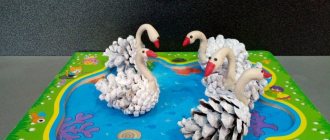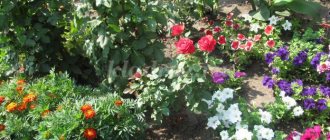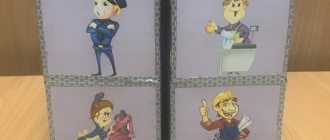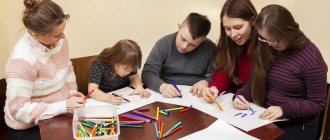Long-term plan for organized educational activities in the Russian language in the senior group
Ni Aliya
Perspective plan for organized educational activities in the Russian language in the senior group
Long-term plan for organized educational activities
for the older group .
Educational field: Communication.
«Russian language in groups with the state language of instruction».
No. Content Number of organized educational activities Timing
1 Topic: “Meeting, greeting”
Goal: Introduce words denoting greeting, farewell into the children’s dictionary, teach them to use words in accordance with the rules of the Russian language (hello, goodbye)
5
Goal: Enriching children's vocabulary through the names of toys,
primary colors, adjectives and numerals within six. 5
3 Topic: “Wild and domestic animals.”
Goal: Enrichment of active vocabulary with nouns,
meaning domestic, wild animals, birds and their young, gla-
heads indicating the actions of animals and people. 7
4 Topic: “Vegetables and fruits.”
Goal: Initial accumulation and active assimilation of new lexical units on the topic through the names of vegetables and fruits, primary colors and adjectives “big”
,
“small”
, etc. 8
Purpose: To introduce the names of body parts. Create conditions for developing skills to coordinate issues
Strong pronouns (whose, whose, whose)
and possessive pronouns
(my, my, my)
with nouns. 4
Goal: Enriching children's vocabulary with nouns denoting family members (mom, dad, grandmother, grandfather, girl, boy, sister, brother, daughter, son, pieces of furniture, verbs denoting actions (washes, plays, knits, waters, draws, stands , lives, etc.)
8
7 Topic: “Utensils and food.”
Goal: Formation of skills to coordinate adjectives with nouns in gender and number (big cup, small plates, etc.)
. 8
8 Topic: “Clothes and shoes”
Goal: Development of understanding of speech, expansion of vocabulary through new lexical units on the topic. 7
9 Topic: “In the garden and vegetable garden”
Goal: Enriching the active vocabulary with nouns denoting vegetables and fruits, adjectives denoting the attribute and property of an object (sweet, round, yellow, etc.)
. Developing the skills and abilities to understand and use interrogative sentences in speech with the word where, to whom? from whom? 5
Goal: Formation and development of listening and speaking skills in familiar and new game learning situations on completed topics and on the topic “Transport”
. 5
11 Topic: “Our favorite fairy tales”
Goal: developing skills in understanding text through reading, instilling interest in Russian folk tales 6
12 Repetition. Purpose: generalization and systematization of acquired knowledge. 4
Enrichment of vocabulary for the development of coherent speech of the child. Without a vocabulary, there is no coherent speech, there is no dynamics in the development of narrative and dialogic speech. Work on enriching vocabulary.
Technological map of organized educational activities for the development of bilingual speech for the middle group “My toys” Technological map of organized educational activities for the middle group Educational areas: “Communication” Section: Development.
Source
Teaching Russian as a second language in kindergarten
Lyudmila Solomeina
Teaching Russian as a second language in kindergarten
Self-education on the topic: Teaching Russian as a second language in kindergarten.
I chose the topic of self-education not by chance, since this is a very important problem for parents and their children who speak Russian as a second language.
In recent years, children of different nationalities who do not speak Russian as a native language are increasingly coming to kindergartens in Moscow.
At home they speak with their parents and other relatives in their native language (for example, Azerbaijani, Armenian, Ossetian, and in kindergarten they begin to master Russian.
The article I came across reveals the system of work of a preschool educational institution for the formation of bilingualism in preschool children. It describes how teaching Russian as a second language to children can be organized, based on the interaction of all kindergarten teachers.
As the results of domestic and foreign studies show, the most promising in relation to such families is an integrative approach, which is implemented in kindergarten. This means that, along with teaching the Russian language, work is carried out aimed at preserving the native language, i.e., at the formation of full-fledged bilingualism in children. Of course, in the conditions of a Moscow kindergarten, in which children of various nationalities are brought up at the same time, it is impossible to organize actual speech work to support each of the children’s native languages, therefore the emphasis is on emphasizing the importance of the child’s command of two languages.
In order for work with bilingual children to be effective, it is necessary to organize joint activities between the kindergarten and parents. In conversations with parents, the kindergarten teacher constantly emphasizes that how developed the child’s native language is will determine what success he will be able to achieve in mastering Russian as a second language. The system of classes for middle-aged children in the group is structured in such a way that the same topic is studied by children at the same time throughout the year. Based on the general context that sets the content of the teacher with all children, the content of the work on teaching children Russian as a second language is determined. Words and adjectives are selected that the teacher includes in his speech addressed to bilingual children. These are phrases that are used during meals, during various activities, when dressing for a walk and during the walk itself, when organizing children’s games or putting them to bed. At the same time, the content of individual lessons with bilingual children is determined, which the teacher conducts in a group in the afternoon. Classes taught by kindergarten teachers help enrich the vocabulary of a bilingual child, assimilate various phrases and speech structures, idiomatic expressions, and make a significant contribution to the work of teaching children Russian as a second language.
For example, when studying the topic “Clothing”, the teacher in the group constantly uses the expression type in appropriate situations.
Put on, (take off, hang, put, put, (red, blue, green - T-shirt, jacket, hat (red, blue, green - scarf, sweater, sock). This is my jacket, These are your sneakers, This is your shoe, Where is yours dress, your scarf. During individual lessons with bilingual children, the teacher in the group conducts didactic games, which also use vocabulary on the topic “Clothing.” The teacher organizes the acting out of dialogues in situations of the “Clothing” store.
Kindness, patience and understanding are the basis of a teacher’s work in a kindergarten group with bilingual children.
One of our main tasks is to help such children establish contact with others so that this does not become an obstacle for the children in their development.
We teach the Russian language in various types of activities, classes, games, everyday life, i.e. when children communicate with each other and with adults, thanks to which they master not only Russian, but also the culture of communication.
Not all children who speak Russian poorly can behave relaxed in public and answer questions publicly. Shyness in such children manifests itself in a lowered head, downcast gaze, a quiet voice, and erratic movement.
We strive to support such children, we invite them to answer the question with an adult, telling them that they will definitely succeed.
Of course, the main thing in working with such children is kindness, patience, understanding and acceptance of the conditions of family national education, if it takes place and does not run counter to generally accepted norms.
We are obliged to help such children cope with their problems. Fear of contacts with other children, isolation, fear of being ridiculed, fear of receiving a negative assessment from an adult - all this interferes with the development of communication and also the development of personality in general.
The teacher should, as often as possible, give positive assessments to bilingual children in the presence of other children, paying attention to even minor successes of the child in various activities.
We constantly celebrate the positive qualities of children and demonstrate our own kind attitude towards children of other nationalities.
Working with parents of bilingual children.
Working with parents is a very important job, since parents often feel that having moved to Moscow, the family should give up using their native language and communicate with children only in Russian, even if the parents themselves do not speak Russian well enough. Kindergarten teachers explain to parents the impossibility of giving up the family’s native language and together with them find optimal options for supporting both the native and Russian languages, i.e., the formation of true bilingualism. It is necessary to convince parents that the more clearly the languages are separated in the child’s environment, the easier it is for him to call everything by its proper name and not confuse languages.
Tips for parents: Parents should be attentive to the speech of their children.
Make sure they pronounce the words clearly enough.
Are they mixing languages?
Do they have time to name all the surrounding objects and actions in this language?
Ask questions about kindergarten more often (how the child spent the day in kindergarten in Russian.)
Offer parents educational games to play at home.
Some parents are afraid that two languages is too much of a burden on the child. Research by scientists shows that this is not the case. Learning languages is in human nature, this activity develops the brain. And then, this can be done fun, in games, with poems, songs, theatrical performances. Childhoods become a whole world richer!
Methods of teaching Russian language:
– natural communication in Russian, when possible, but this is not mindless speaking for the sake of filling pauses, but structured, progressively more complex, easy-to-understand adult speech addressed to a child;
– conducting special classes that can be conducted based on the children’s native language, in different types of activities and at special moments by native speakers of a second language;
– use of sound and intonation aspects of speech. The ability to recognize, identify and realize units of language and speech arises, in which language plays the role of a catalyst for cognitive processes: everything that exists in the surrounding reality should receive a second name;
– use of general methodological principles of working with preschoolers (active communication, play, entertainment, clarity, repetition, systematicity, flexibility);
– use of linguistic material based on the native language and organization in the comparative aspect of languages and cultures, mutual enrichment of cultures.
Using second language techniques in artistic creativity.
Working with bilingual children, I encountered another problem: when a teacher has planned some kind of practical activity, he, first of all, must demonstrate the purpose of this activity: visually - or with the help of translation - verbally. If the task is creative, you first need to discuss the situation itself in which the result of the children’s work will be used, what it should be and why. The teacher explains his work as much as possible, shows and names all the tools necessary for its implementation, draws, perhaps on a large sheet of paper or board, a work plan or one of the options for a craft or drawing. Then the teacher works in front of the children and achieves some kind of intermediate or final result, depending on the complexity of the plan. When the children began to work, the teacher approaches each one in turn, names the details of the image, tools, repeats fragments of the explanation, asks the child what he is doing now and what he will do later, offers options for developing the plan, encourages successful aspects of the work.
There are typical figures of speech: For example, for modeling we need: plasticine, oilcloth, stick; plasticine can be crushed, rolled, squeezed, pressed; You can make lumps, balls, sausages, and cakes from it; characteristics of objects: long, short, round; expressions: with both hands, between the palms, in a circular motion; After the children have done the crafts, you can play (Here’s an apple for you, doll, look how big, beautiful, smooth it is. It’s probably very tasty, sweet. Let’s try it! Yes, very tasty. Do you want another piece? Take a plate and put it on the table You see the doll took the apple in her hands and eats it.
All methods are very good, but the most important thing: Conclusion: children should feel comfortable, know that they are welcome in kindergarten, want to play with them, are accepted and loved very much because they are an individual, since each person comes to this world is unique in its own way and its presence enriches everyone.
Notes on educational activities in the Russian language in the senior group “Favorite time of the year”
Shonchalai Shanmak
Notes on educational activities in the Russian language in the senior group “Favorite time of the year”
Abstract of GCD in the Russian language in the senior group.
Conducted by the teacher of the senior group of MBDOU d/s "Khunchugesh"
With. Ak-Durug Shanmak Sh. O.
Topic: Favorite time of year
Goal: formation and development of skills and abilities of practical knowledge of the Russian language in oral form . Continue to introduce children to words meaning seasons - autumn , winter, spring, summer. Learn to make short sentences based on a picture, distinguish the seasons , understand and use words denoting the seasons . Repeat the words of the topic: Colors. Develop coherent speech and enrich children's vocabulary. Foster interest and respect for the Russian language .
Work on the pronunciation of voiced and soft consonants.
Visual aids: doll, images of the seasons ; snowflakes, flowers, green and yellow leaves cut out of paper.
Summary of the final lesson in the preparatory group “Experts of the Russian language”
Venera Tasemenova
Summary of the final lesson in the preparatory group “Experts of the Russian language”
Summary of the final lesson in the preparatory group
«Russian Language Experts»
-educational - clarify children’s knowledge on the topics covered, teach children to answer questions in complete sentences.
-developing - to develop auditory attention, thinking, voluntary attention, imagination, memory, intonation expressiveness of speech, curiosity ;
- educational - to cultivate perseverance, accuracy, desire to speak Russian , interest in the lesson .
Equipment. Demonstration material: illustration of a picture depicting autumn, winter, summer, spring. Illustration of the picture “Seasons”
, spring flowers, emoticons.
Progress of the lesson:
Surprise moment. (Doll Katya arrives)
:
Q- Hello guys! Doll Katya, you haven’t forgotten the names of the children.
R- No. My name is Zhenia.
(The doll fits every child.)
Q- Let's tell the doll Katya what new words we learned in the last lesson. Look at the picture and name the season .
D-Spring, summer, autumn, winter.
B- And now each of you will tell the doll what time of year he likes (approaches each child with the doll.)
D- I like autumn. I like winter.
K-Misha, do you like winter?
K- Aidan, do you like spring?
B- Well done! Each season has its own color . What color is winter? That's right, white (ak)
. Repeat after me. Winter is white. What color is spring? Of course spring is green. What color is summer? Summer has red, yellow, blue and green colors. Autumn also has its own color. Autumn yellow color.
Bent over once, bend over twice
He spread his arms to the sides,
Apparently I couldn't find the key.
To get us the key,
You need to stand on your toes.
Q - Now let’s switch, I will name the time of year , and you pick up the corresponding object. (V-l calls Summer, the children pick up flowers, spring - the children pick up green leaves, etc.)
B- Well done guys! And now the Katya doll also wants to play with you. The game is called "Confusion"
.
(The doll points to the snowflake)
. Summer?
(The doll points to the flower)
. Spring?
Doll: do you like summer? Why do you like summer? All children love... what? That's right, summer.
Q- What can you do in the summer?
D- I can run. I can swim. I can jump. I can play.
B- And now we’ll play the game “Pantomime”
.
I will show you with the help of gestures what I do at this time of year , and you will name this time of year .
On the topic: methodological developments, presentations and notes
Lesson notes for children with ODD in the sixth year of life. Designed to develop coherent speech and update vocabulary on the topic “Vegetables”.
Goal: to develop children’s interest in books and the need to read.
Objectives: - Introduce children to the flora and fauna of their native land - Teach children to write short stories about the animals of their native land - Cultivate in children a caring attitude towards wildlife and desire.
The summary is intended for children of the senior group of mental retardation.
The summary assumes that children will be introduced to Polkhov-Maidan painting during art classes.
The material may be useful to kindergarten teachers.
To acquaint children with the history of toys, to form children’s knowledge about the functional purposes of toys.
Source






